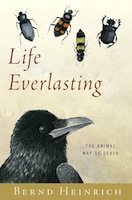If there was one thing I could change (and there is, in fact, only one thing I would change) about Bernd Heinrich’s Life Everlasting; the Animal Way of Death, it would be the subtitle. For while a portion of the book does in fact directly address the manner in which select members of the animal kingdom die and their remains are “undertaken” – e.g., Nicrophorus beetles burying mice, oceanic bottom-dwellers deconstructing “whale falls” in the total darkness of the deep – there is a far larger story being told by Dr. Heinrich than is encompassed by the word “death.”
I would have rather chosen something along the lines of “the Natural Cycle of Destruction and Creation;” for this is really the core topic of the essays included in the book. How out of the death and deconstruction of one particular form of life (Heinrich does not limit himself to the Kindgom Animalia but ventures into those of the Plantae, Fungi, Bacteria, and Protozoa as well) other forms arise or are sustained. With a combination of the erudition of a professor (Dr. Heinrich is in fact Professor Emeritus in the Department of Biology at the University of Vermont), the inquisitiveness of a field biologist, and the ground-level experience of a naturalist and and hunter, Dr. Heinrich leads his readers through a selection of his experiences with and investigations into just how this cycle plays out continually all around us – and in a final concluding chapter, reminds us how we are not outside of it, despite how much we may try to convince ourselves that we are.
Readers of Dr. Heinrich’s previous books, particularly his magnificent Ravens in Winter and his subsequent book devoted to the species, The Mind of the Raven, will be very pleased to learn that a sizable portion of Life Everlasting draws upon his experiences with these undertakers of the northern forests. However as important as these highly intelligent corvids are in ensuring the continuation of the cycle of deconstruction and regeneration, it is upon the activities of a much smaller species that so much of the cycle depends.
Despite what that famously melancholy Prince of Denmark may have declared, we – and much of the other larger forms of life with which we share the planet – are not so much food for worms as food for beetles. From the previously mentioned mouse-burying Nicophorus beetles Dr. Heinrich observes outside his cabin door, to the longhorn and other tree boring beetles that emerge from his rough-hewn furniture, to the bird-sized rollers of elephant dung that he investigates on the plains of Tanzania, the reader is presented with a few tantalizing glimpses into the astonishing variety of the planet’s Coleoptera, without the activities of which the entire cycle would largely come to a screeching halt.
As short a book as it is (it could have easily been twice as long and still only grazed the surface of the myriad variations of its seemingly inexhaustible subject) Life Everlasting is a lively collection of stories, investigations, reflections, and musings all joined together by a central theme – that of not just how the remains of the dead are reincorporated into the cycle of life but, perhaps more importantly, why they are, and in the concluding chapter, what happens when they are not. Indeed, the final chapter, “Beliefs, Burials, and Life Everlasting,” is one that should be read even by those with no previously expressed interest in natural history, ecology, or biology (hard as it is to believe, such people do in fact exist – in regrettably sizable numbers, so I am told) for in it Dr. Heinrich makes his case for a profound reconsideration of how we humans treat the remains of our own dead, and of how in a quest for a physical immortality we can never achieve we sacrifice a larger and far more holistic one that we can.
 Book Title: Life Everlasting; the Animal Way of Death
Book Title: Life Everlasting; the Animal Way of Death
Author: Bernd Heinrich
Publisher: Houghton Mifflin Harcourt
Format: Hardcover
ISBN-13/ EAN: 9780547752662
Published: 19 June 2012
In accordance with Federal Trade Commission 16 CFR Part 255, it is disclosed that the copy of the book read in order to produce this review was provided gratis to the reviewer by the publisher.
If you enjoyed reading this, please consider signing up for The Well-read Naturalist's newsletter. You'll receive a helpful list of recently published reviews, short essays, and notes about books in your e-mail inbox once each fortnight.
